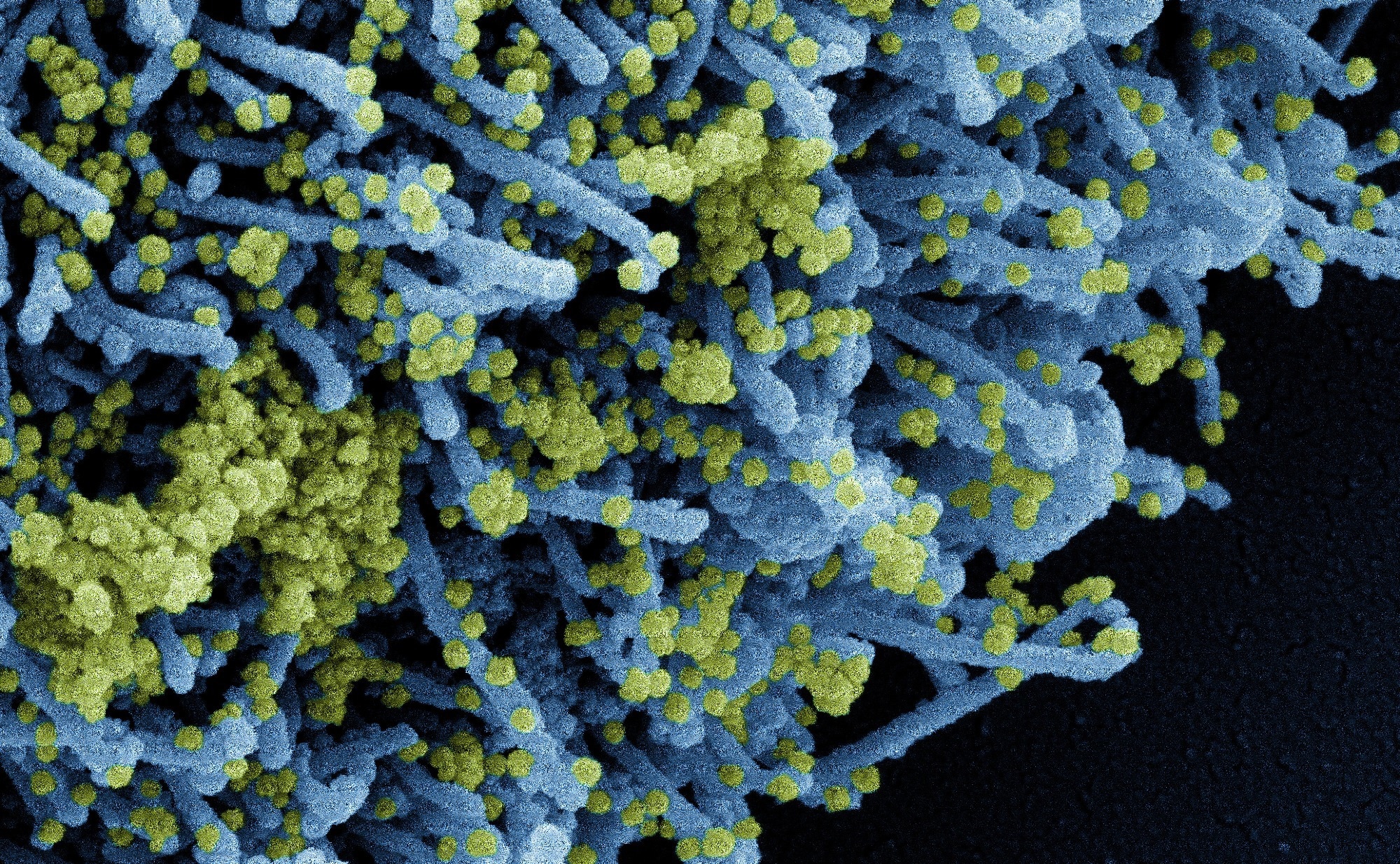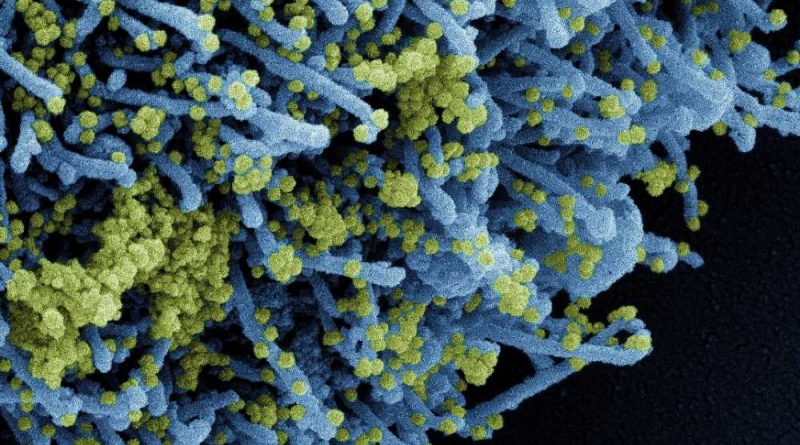Evidence review on "long-distance" airborne transmission of SARS-CoV-2
In a recent study published in the BMJ, researchers investigated the factors that might influence the long-distance (more than two meters) airborne transmission of severe acute respiratory syndrome coronavirus 2 (SARS‐CoV‐2) in real-world indoor settings, e.g., workplaces and residential apartments.
Over a short-range, i.e., under two meters, SARS-CoV-2 transmits via respiratory droplets and aerosols. However, there is a lack of evidence on whether it transmits for long distances via aerosols indoors.
 Study: Long distance airborne transmission of SARS-CoV-2: rapid systematic review. Image Credit: NIAID
Study: Long distance airborne transmission of SARS-CoV-2: rapid systematic review. Image Credit: NIAID
About the study
In the present study, researchers comprehensively skimmed through epidemiological observational studies and outbreak investigations published between January 2020 and July 2020 to identify places where human-to-human SARS-CoV-2 transmission most likely occurred. Two reviewers independently screened these studies using an online tool Rayyan Systems, and a third reviewer resolved discrepancies if there were any.
The data sources included Ovid Medline, Ovid Embase, medRxiv, Arxiv, and the World Health Organization (WHO) coronavirus disease 2019 (COVID-19) research database. The primary study outcome was an incidence of SARS-CoV-2 infection contracted through long-distance and factors influencing the same.
The quality criteria checklist comprised ten questions, with four critical questions. The researchers strictly adhered to quality assessment related to exposure of transmission routes and the validity of outcome assessment. Finally, they used the Grading of Recommendations, Assessment, Development, and Evaluation (GRADE) framework to classify the evidence for a specific outcome as high, moderate, low, or very low certainty.
Study findings
The researchers identified 18 studies, all investigating clusters of COVID-19 outbreaks across Asia, Europe, Oceania, and the United States. These studies covered indoor settings, such as apartment blocks, hotels, restaurants, buses, food processing facilities, courtrooms, offices, and singing concerts.
Seven outbreaks identified via these studies occurred between January and March 2020, i.e., the early phase of the COVID-19 pandemic when community transmission was likely higher than perceived. Consequently, these studies considered only symptomatic participants as potential secondary cases. Moreover, the authors concluded that long-distance airborne SARS-CoV-2 transmission likely occurred for some or all transmission events in 16 of 18 studies. More importantly, inadequate air replacement, unidirectional airflow, and activities associated with increased aerosol emissions, such as singing or speaking, increased the likelihood of long-distance aerosol transmission.
Four of 18 studies made observations based on extensive epidemiological investigations and genome sequencing. Hence, they provided solid evidence for long-distance airborne SARS-CoV-2 transmission. The first such study was by Eichler et al.; however, they could not exclude close contact or the fomite route of SARS-CoV-2 transmission for the secondary cases. The studies by Shah et al., Groves et al., Han et al., Hwang et al., and Vernez et al. fetched limited results (could not rule out fomite completely) due to their methodological limitations. However, their findings suggested that long-distance airborne SARS-CoV-2 transmission could have occurred for some if not all the events. Finally, Sarti et al. reported an uncertain prospect of long-distance airborne transmission in an office outbreak despite adequate COVID-19 measures in place.
Further, 11 of the 18 studies mentioned that masking was compulsory in the indoor settings of interest without reporting on adherence to the mask use. Due to limited information, the study reviewers could not find evidence of long-distance airborne transmission. Also, the SARS-CoV-2 transmission setting and distance over which airborne transmission was perceived to have occurred could not be graded due to the observed heterogeneity between studies.
Conclusions
The evidence from the current rapid systematic review was of very low certainty. It highlighted the challenges in identifying long-distance SARS-CoV-2 transmission events and their under-reporting. More importantly, it demonstrated that COVID-19 outbreaks related to long-distance airborne transmission were rare. Nevertheless, the study found evidence supporting the feasibility of airborne SARS-CoV-2 transmission as an important route in indoor settings, especially in poorly ventilated spaces. Therefore, ventilation systems in indoor settings should be paid attention to when found inadequate. Also, activities like singing and loud speaking that increase aerosol emissions should be avoided in indoor public settings (e.g., pubs, restaurants).
Future outbreak investigations should deploy mixed methods, from genomic analysis to environmental assessments for robust results. Additionally, such studies should be conducted as early as possible to lessen recall bias.
- Long distance airborne transmission of SARS-CoV-2: rapid systematic review, Daphne Duval, Jennifer C Palmer, Isobel Tudge, Nicola Pearce-Smith, Emer O’Connell, Allan Bennett, Rachel Clark, BMJ 2022, DOI: http://dx.doi.org/10.1136/ bmj-2021-068743, https://www.bmj.com/content/377/bmj-2021-068743
Posted in: Medical Science News | Medical Research News | Disease/Infection News
Tags: Coronavirus, Coronavirus Disease COVID-19, covid-19, Food, Genome, Genomic, Pandemic, Research, Respiratory, SARS-CoV-2, Severe Acute Respiratory, Severe Acute Respiratory Syndrome, Singing, Syndrome

Written by
Neha Mathur
Neha is a digital marketing professional based in Gurugram, India. She has a Master’s degree from the University of Rajasthan with a specialization in Biotechnology in 2008. She has experience in pre-clinical research as part of her research project in The Department of Toxicology at the prestigious Central Drug Research Institute (CDRI), Lucknow, India. She also holds a certification in C++ programming.
Source: Read Full Article



